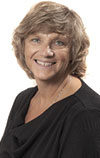Training is an essential part of every job, in every industry. You want your employees to do their jobs in a productive, meaningful and correct way.
Results from a 2014 USDA study found the value of training employees to be high; however, only 60% of dairy farms in the U.S. offered regular, timely and easy-to-understand training and materials.
The key to good training is to first determine what type of training each position requires. A herdsperson will not need the same type of training as a manager.
With our programs, to determine what trainings each position requires, we start with a "job hazard analysis.”
A job hazard analysis is a process where you write down each step of a task or job, then determine what the hazards of that job are, like the example shown in Table 1.

Anything determined to be a high risk must have a safe operating procedure attached to it. A safe operating procedure includes preoperational inspections, operational hazard checks and postoperational inspections. Safe operating procedures also include required personal protective equipment (PPE), potential hazards and the steps on how to complete a job. Keeping with the example of a herdsperson needling calves, the hazards are back strain injury, awkward position handling calves and needle prick injury. The PPE is wearing gloves, and the basic steps are:
- Identify which calves require a needle
- Prepare the syringes
- Needle the calves
- Clean syringes
- Documentation
These steps should be written down and given as a training to each employee who will be required to do this job. Additionally, documentation is an essential part of training. When employees take training, have them sign a sheet that details the date, the trainer, the topic and any important details of the training, and keep this record of training in their employee file.
New employees
Employee orientation is an opportunity to set the tone for the course of the employment. New employee orientation should be as much about training the employee as it is making them comfortable on the farm.
After all the paperwork has been signed, but before training begins, take new employees for a walk or drive around the farm. Show them where everything is located so they can get their bearings. This also allows new employees to get comfortable with their surroundings and gives them an opportunity to ask questions of the person who will be training them.
A critical step of new employee orientation is to have a list of training that you would like the employees to do before they begin working. Having a list keeps you organized and prevents you from missing any key steps. It may be easiest to have a new-employee training booklet. This booklet or binder should include everything new employees need to read, understand and sign off on as training is completed. Having a binder helps keep everyone organized and maintains all documentation in one place.
After training, it is important to have new employees do the actual task while supervised by the trainer or another senior team member. For example – returning to the example of needling calves – after new employees have completed the training, read the safe operating procedure and watched someone else do the task, then they can try. This gives them an opportunity to learn on the job, which is the most effective way of learning and instills management with the confidence that the new employees can do the job properly, safely and effectively.
Existing employees
Investing in your employees through training will help to improve employee retention, safety on the farm and workplace culture.
Even the most seasoned employees can make mistakes or fall into bad habits. Job task refreshers can help combat this. Schedule annual refresher trainings for all employees. Go over each job they do and get their input if they feel there is a better or more efficient way to complete each task. When you do your annual performance appraisal, include a section on ways that they can improve task processes.
Involving employees in this process helps to build individual and team confidence and gives employees the opportunity to take leadership and responsibility over their roles.
Using these strategies can help you to train your employees as part of your on-farm safety program. Employees are an essential part of the farm and farm management system. Investing in good training means you are investing in your farm for years to come.











